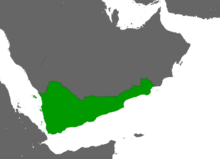| Aksumite invasion of Himyar | |||||||||
|---|---|---|---|---|---|---|---|---|---|
| Part of Roman–Persian Wars | |||||||||
 The Himyarite Kingdom in 525 AD, just before King Kaleb's conquest | |||||||||
| |||||||||
| Belligerents | |||||||||
| Commanders and leaders | |||||||||
| Yūsuf Dhū Nuwās † | ||||||||
| Strength | |||||||||
| 120,000 soldiers at the Siege of Najran | ||||||||
| Casualties and losses | |||||||||
|
| ||||||||
The Aksumite invasion of Himyar consisted of a series of two invasions from 518 to 525 fought between the Christian Kingdom of Aksum and the Jewish Himyarite Kingdom. The wars functioned as proxy wars waged by the former on behalf of the Roman Empire during the Roman-Persian Wars with the ultimate goal of establishing an anti- Sasanid bloc in Arabia Felix. [5]
Background
During the 2nd and 3rd centuries AD, the Southern part of Arabia, known in antiquity as Arabia Felix, had experienced Aksumite political and military involvement, as the Aksumites had occupied relatively peripheral areas in the region and formed alliances with the local tribes. [6]
During the late 4th century AD, the local population converted to Judaism, and a Jewish kingdom known as Himyar was established. [7] During the reign of Himyarite King Yanuf Dhu Shanatir, the Aksumites established diplomatic relations with the Himyarite capital city of Ẓafār, but the friendly relations between the two kingdoms did not last long, as in the second decade of the 6th century AD, the Jewish Himyarites began to persecute the Christian community of Southern Arabia. [8]
A severe drought in the 6th century weakened the Himyarite kingdom and contributed to its eventual conquest by Aksum. [9]
Aksumite invasion of 518
In response to the persecution of Christians, Negus Kālēb dispatched a punitive expedition to Arabia Felix led by general Ḥayyān. [10] The initial military campaign was successful and the Aksumites brought to power a Himyar Christian by the name of Maʿdīkarib Yaʿfur. [11] However, in 522 Yūsuf Dhū Nuwās declared himself king in a successful coup d'état and began to persecute Christians once again by setting fire to churches and attacking Christian communities in Ẓafār and Tihāma. [12] [13] In 524, Yūsuf Dhū Nuwās besieged the Christian city of Najran and ordered his troops to slaughter the whole city for refusing to convert to Judaism, and news of the massacres rapidly spread across the region. [13] [14]
Aksumite invasion of 525

In response to the massacres of Christians by Dhū Nuwās, the Byzantine emperor Justin I sent a call to arms through the Patriarch of Alexandria Timothy IV, and Negus Kālēb decided to lead his armies in person into another invasion in 525. [13] [15] The Aksumite army was reinforced by the Roman army sent by the Byzantine emperor Justin I. [14] Following the defeat of Yūsuf Dhū Nuwās, another Himyar Christian by the name of Sumūyafa Ashwa was crowned King of Himyar, soon after Christian churches were rebuilt and Christians who were forcibly converted to Judaism were allowed to revert to Christianity. [16]
Aftermath
In 535, a Christian Aksumite general by the name of Abrǝhā revolted against Sumūyafa Ashwa and seized power, declaring himself King of Himyar. After several unsuccessful military campaigns sent by Negus Kālēb to overthrow the new king, Abrǝhā remained in power in exchange for a tribute and soon after established diplomatic relations with the Aksumite Kingdom, the Byzantine Empire and the Sasanian Empire. [16]
See also
References
- ^ D. W. Phillipson (2012). Foundations of an African Civilisation: Aksum and the Northern Horn, 1000 BC – 1300 AD. Boydell & Brewer Ltd. p. 204.
- ^ P. Yule (2013). "A Late Antique Christian king from Ḥimyar, southern Arabia, Antiquity, 87". Antiquity Bulletin. Antiquity Publications: 1134.
- ^ Rukuni, Rugare (2020). "Religious statecraft: Constantinianism in the figure of Nagashi Kaleb". Theological Studies. 76 (4): 5. doi: 10.4102/hts.v76i4.5885. S2CID 225161400.
- ^ Jacques Ryckmans, La persécution des chrétiens himyarites au sixième siècle, Nederlands Historisch-Archaeologisch Inst. in het Nabije Oosten, 1956 pp. 1–24; A. Jamme, W.F., Sabaean and Ḥasaean Inscriptions from Saudi Arabia, Instituto di Studi del Vicino Oriente: Università di Roma, Rome 1966, p. 40
- ^ Hatke, George (2011), Africans in Arabia Felix: Aksumite Relations with Himyar in the Sixth Century C.E. Vol. 1, p. 4
- ^ Preiser-Kapeller, Johannes; Reinfandt, Lucian; Stouraitis, Yannis (2020). Migration Histories of the Medieval Afroeurasian Transition Zone: Aspects of Mobility between Africa, Asia and Europe, 300–1500 C.E. Leiden: Brill. p. 306.
- ^ Bowersock, Glen W. (2011), "The Rise and Fall of a Jewish Kingdom in Arabia", Historical Studies, retrieved 14 July 2022
- ^ Preiser-Kapeller et al. (2020) p. 307.
- ^ "New Research Links Sixth-century Droughts to the Rise of Islam : UMass Amherst". www.umass.edu. Retrieved 2022-07-17.
- ^ Rukuni (2020) p. 5
- ^ Preiser-Kapeller et al. (2020) p. 307-308.
- ^ Christian Julien Robin,'Arabia and Ethiopia,'in Scott Johnson (ed.) The Oxford Handbook of Late Antiquity, Oxford University Press, 2012, pp.247-333.p.282
- ^ a b c Preiser-Kapeller et al. (2020) p. 308.
- ^ a b Bowersock (2011)
- ^ Jeffreys et al. (1986):433–434
- ^ a b Preiser-Kapeller et al. (2020) p. 308